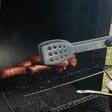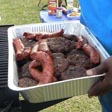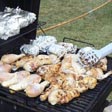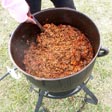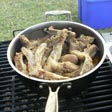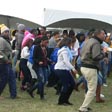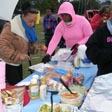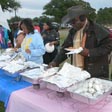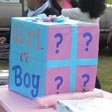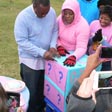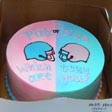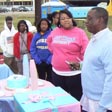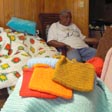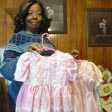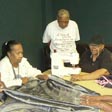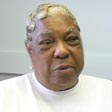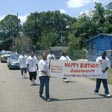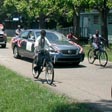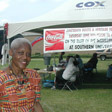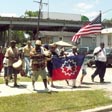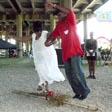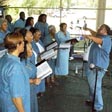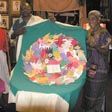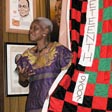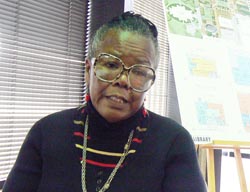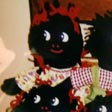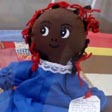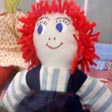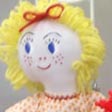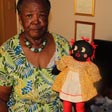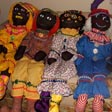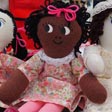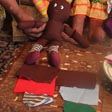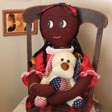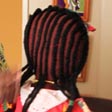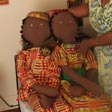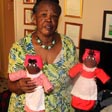African American Traditions in Baton Rouge
Photos by James TerryPhotos and Text by Maida Owens
Russell Wright, Tailgating
Zachary, East Baton Rouge Parish
Russell Wright is a barbeque pit master who has been tailgating since the 1990s when his father would entertain his friends and family when he was in the Southern University band. He's taken over as chief cook for his tailgate parties for home football games and those on the road. He says he tailgates for "as many home games as Southern University has. That's the rich tradition we tailgate in. But also we get on the road sometimes if we go to Norman, Mississippi. We go to Alcorn, and of course, Jackson, Ms. That's like home away from home tailgating at this point. That's probably one of the favorite on-the-road tailgates probably of anybody that's a Southern Jaguar fan." His favorite is ribs, but also will cook chicken and roast. He has three different types of barbeque pits so that he can grill, smoke, and even bake potatoes. He also brings butane burners for dishes like chili. At a typical tailgate, he will feed about forty to fifty people, but for Homecoming there may be one hundred more. At his tailgating party for the 2014 Southern University vs Texas Southern University football game, they served ribs, roast, chicken, sausage, burgers, pigtails, chili, baked potatoes, potato salad, green salad, and deviled eggs.
Tailgating is so important to Russell and his wife Latonya that in 2014 they decided to reveal the gender of their baby to family and friends at a tailgating party. A “reveal box” contained a cake with half-pink, half-blue icing. They cut it to reveal a blue cake and that their baby was a boy.
Cloise Leatherman, Crochet, Knitting, Sewing
Baker, East Baton Rouge Parish
Cloise Leatherman of Baker says that she started crocheting at the age of about seven or eight. She learned from a older woman in the neighborhood who had no children. Cloise says shared about learning from this woman:
There must have been about ten or eleven [children]. She'd have all of sitting around on her porch. She bought all the thread and all the needles. And she gave each one of us a little brown bag. But you when you went to crochet she didn't let you do anything with it. You had leave it there until you learned to crochet. It had your name on it. But then when you learn to crochet, you took your bag home with you. Every evening we'd sit on that porch. My goal is to teach other little kids how to crochet.
Today, she crochets and knits Bible covers, caps, blankets, and quillows (quilted pillows). A multitalented woman, Cloise teaches sewing, knitting, and dress making at the Charles R. Kelly Community Center in Baton Rouge.
Sadie Roberts-Joseph, Juneteenth Celebrations
In 1991, Sadie Roberts-Joseph organized the first Juneteenth celebration in Baton Rouge. She was working at the Glenn Oaks Community Center in Zion City and starting CADAV (Community Against Drugs and Violence). She wanted to do something that would help community members feel better about their community. Two little girls motivated her. She took one to see a house being remodeled. She reflects on one of these girls:
And when she got to the kitchen, there was a rotating pantry. And she looked at that [and said], ‘Oh, this would be a good place to hide when they be shooting.’ And it just kind of broke my heart. Children living in fear looking for a place to hide. And basically, I knew that when children came home on the weekend and go back to school, there was pretty much nothing exciting that they could talk about except the gunshots, what happened, the negative things on their street.
She decided, “the parade would give something positive to the community, to uplift it. Many children were unable to go to the parades that were downtown and other locations simply because they didn't have the transportation. Or well, they just didn't go.” So she started the Juneteenth parade. The parade starts in the Banks Subdivision in Scotlandville and ends at a celebration in [inaudible] Park.
Sadie went on to found the Odell S. Williams Now and Then African American Museum on South Boulevard in Downtown Baton Rouge where she serves as curator. There she has had Juneteenth celebrations by the museum under the Interstate 10 bridge ramp with gospel, jazz, art and history exhibits, games, and activities for children.
The museum features a Juneteenth quilt made by two volunteers in 2007. Sadie Roberts-Joseph uses it as a teaching aid with visiting school groups and displays it for the Juneteenth Celebration. The quilt features the African colors of red, black and green. In the center is a woman holding a baby to represent Mother Africa and it is surrounded by the names of the eleven slavery states. Louisiana is in gold in the upper left. The Wreath of Unity quilt was made from the tracings of hands by visitors.
Barbara W. Franklin, Multicultural Folk Doll Artist
Baton Rouge, East Baton Rouge Parish
Cloth doll maker Barbara W. Franklin first learned to work with her hands as a little girl in New Orleans. When she was about 7 or 8 years old, her teacher taught her basic embroidery skills including transferring an embroidery pattern on a piece of muslin. This early introduction to working with her hands stayed with her. She says, "From then on, I've always worked with my hands. It's really part of my gift from God-working with my hands."
She drew upon those early lessons later when she needed to supplement her income as a single parent. In 1978, she was inspired to make cloth dolls while passing a gift shop in the French Quarter and she said, "I saw little black dolls in the window of all shapes and sizes so colorful and cute. . . . And I thought to myself, 'I could make those.'" She proceeded to gather the materials and found a pattern with dolls of different sizes and made some dolls.
Her can-do attitude and drive is evident when she relates her next steps which led to dollmaking:
[A lady] suggested to me that I take [my handmade dolls and park] behind the . . . main post office in New Orleans . . . and open my trunk and display my dolls so that when the postal employees came out for lunch, they would see my dolls and possibly purchase the dolls from me. Well, it didn't work out that I got a sale that day, but a very lovely young lady who worked at the post office saw my dolls and admired them and suggested to me that I take my dolls down to the French market where they sell the fruits and vegetables.. . . So that's exactly what I did. I went down to the French Market Community Flea Market.
The manager of the market was so impressed with her dolls that he assigned her a space on the main aisle which was reserved for handmade items. This space ensured that her work would be seen not only by locals, but by tourists from all over the world. She sold her dolls there for almost eight years and then when Jax Brewery opened on Decatur Street in the French Quarter, she was also able to open a space to sell her dolls in the Jax Brewery Millhouse. She also participated in the New Orleans Jazz and Heritage Festival, the Black Heritage Festival, the Celebration of the African Child in Congo Square, and others around the state, including Sugarfest in Port Allen, Melrose Arts and Crafts Festival and the Northwestern State University Folk Festival in Natchitoches, FestForAll in Baton Rouge. She also participates in the Arts Council of Greater Baton Rouge's Arts Market which is held the first Saturday of each month.
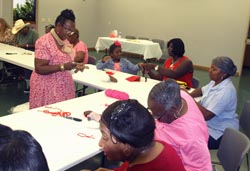
Then came the requests for workshops and exhibits, especially at libraries in both New Orleans where she was born and lived and then in Baton Rouge where she moved following Hurricane Katrina in 2005. Her workshops attract both children and adults, including educators so that they can teach their students. The library workshops are a way for her to give back to the community. She especially likes to teach children because she knows from her own experience that learning such skills can have life-long impact. She wants "children to learn how to use their hands, to fulfill themselves, to help with their self-esteem and just to be able to be self-sufficient." After many years of making dolls full time, she decided to use her Bachelor of Arts degree in Early Childhood Education from Xavier University, but continued to make dolls.
Franklin compares making dolls to baking. She says, "I make my handmade cloth dolls just like grandma makes her delicious homemade biscuits from scratch." She describes her process:
I begin with a vision in my mind that proceeds to fabrics, my hands, scissors, pins, needles, threads, and a sewing machine. I sew the doll body parts, stuff them with fiberfill, continuing with embroidery threads, paints, paint brushes, assortment of fabrics for doll clothing, including laces, rick rack elastic, ending with buttons, bows, ribbons, and giving the doll a name and hand signing each doll.
Her dolls tell stories and she never forgets a doll. She says that "they show love." Since she wants the doll to connect with the person, her dolls have changed over time. She reflects on how her growing audience changed her dolls:
When I first started making dolls, the dolls were made out of black fabric. I introduced brown fabric to my dolls back in the early [19]80s. Today, I use black fabric, brown fabric, café au lait, a Creole doll, and also a white doll. What got me started making the white dolls, I went to a doll exhibit and sale . . . and the various participants wanted white dolls because their little grandchildren were white and they didn't necessarily want a chocolate doll. So then I had to tell myself that if I am going to make dolls, I need to make them of all colors to please everybody.
As a result, how she describes her doll making has changed. She explains, "When I first started making dolls I said 'Barbara W. Franklin, African American Doll Artist.' Now I refer to myself as 'Barbara W. Franklin, African American Multicultural Folk Doll Artist.' That means that I make dolls of all different cultures."
After making dolls for over three decades, Franklin has left a legacy of dollmaking. She still loves to make dolls and feels blessed by those who buy them and appreciate her dollmaking skills. Her goal is to bring joy to others.
Sources
Franklin, Barbara W. 2015. Interview by James Terry, February 28.
Franklin, Barbara W. 2015. Personal Communication by Maida Owens, October 7.
Leatherman, Cloise. 2014. Interview by James Terry, September 9.
Roberts-Joseph, Sadie. 2014. Interview by James Terry, February 5.
Roberts-Joseph, Sadie. 2016. Personal Communication with Maida Owens, June 24.
Wright, Russell. 2014. Interview by James Terry, March 20.



